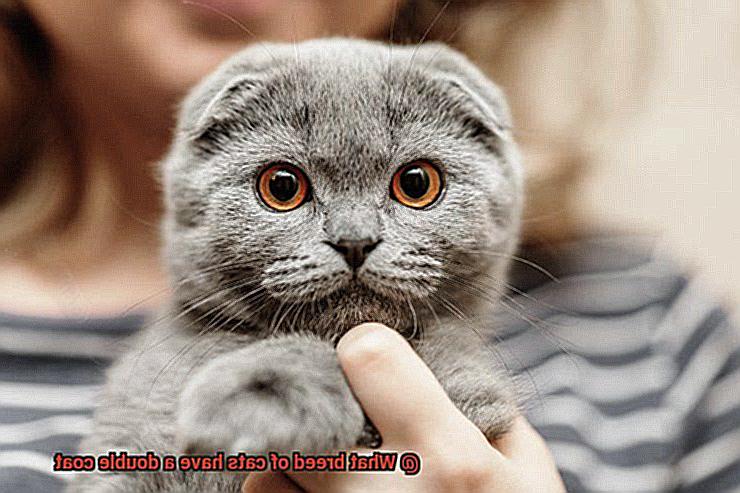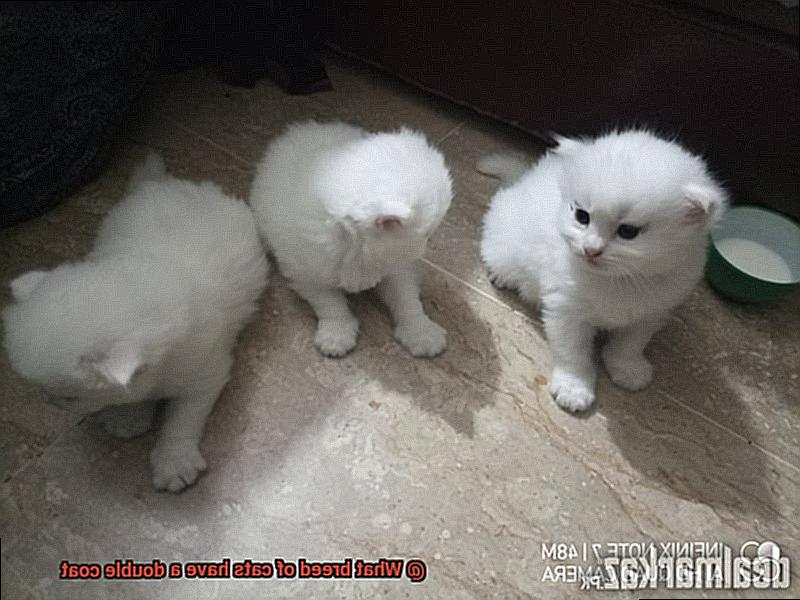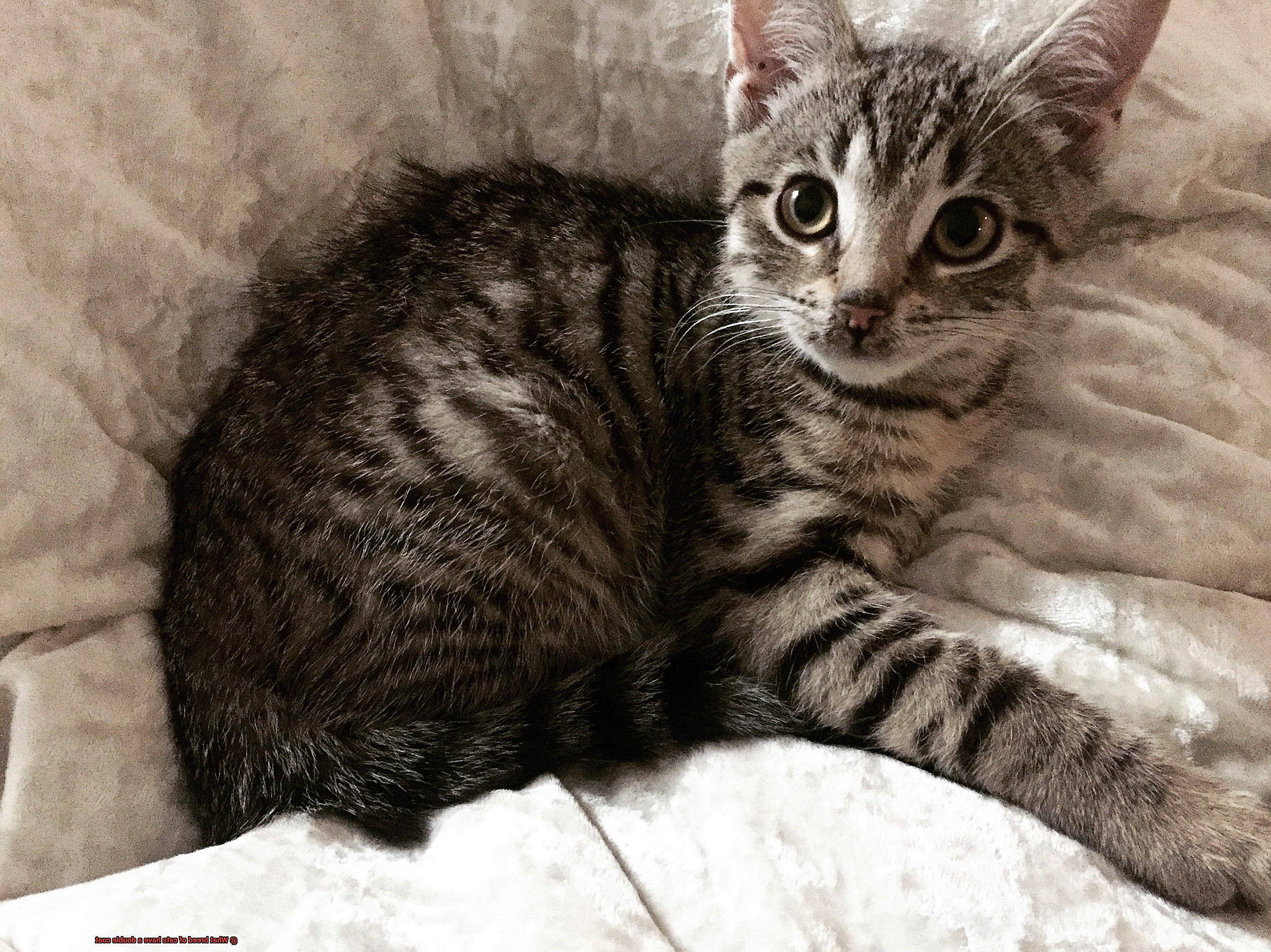Are you a cat lover who can’t resist snuggling up to a soft and fluffy feline friend? Well, have you ever wondered why some cats have longer, softer, and fluffier coats than others? The answer lies in genetics. In the world of cats, there are sleek and shiny ones with fur that seems to glisten in the sun. But what about double-coated cats? These kitties take “fluffiness” to the next level.
Double-coated cats boast two layers of fur; a thick and plush undercoat that keeps them warm and cozy, and a longer, coarser topcoat that protects their skin from dirt and water. However, these magnificent breeds require more grooming attention as they tend to shed frequently.

Now comes the question: which breeds of cats possess these marvelous double coats? You might be surprised to find out that both purebred and mixed-breed cats can have double coats. Some of these breeds include Siberian, Norwegian Forest, Himalayan, Persian, Maine Coon cats, among many others.
If you’re searching for a fluffy feline companion or just curious about the fascinating world of cats – read on. Discover more about these unique qualities of gorgeous double-coated cats. They will make your heart melt with their adorable fluffiness.
What is a Double Coat?
Let’s talk about double coats. A double coat is a fur characteristic found in certain animals, including cats, where the coat comprises two layers – an outer layer of long, coarse guard hairs and an inner layer of short, soft undercoat hairs. This combination helps cats regulate their body temperature in various weather conditions and provides insulation against both cold and heat.
Many cat breeds have double coats, such as the majestic Maine Coon, the elegant Persian, the robust Norwegian Forest Cat, the hardy Siberian, and the striking Himalayan. These breeds have evolved to survive in colder climates and to regulate their body temperature in different weather conditions. Their double coats help them stay warm in winter by trapping air between the layers of fur and cool in summer by shedding their undercoat.

It’s important to note that not all cats with long hair have double coats. Some breeds, like the Balinese and Javanese, have single coats that are silky and fine. These cats still require regular grooming and maintenance to keep their coats healthy and free from mats and tangles.
Proper grooming is essential for cats with double coats to prevent matting and hairballs. Good nutrition and hydration can also keep their skin and coat in tip-top shape. Knowing which breeds have a double coat can also help you choose a cat that is best suited to your climate and living situation.
Aside from insulation and temperature regulation, double coats offer additional protection for cats from predators and environmental hazards. The outer guard hairs repel water and dirt, while the soft undercoat provides cushioning against bumps and scratches.
Breeds with a Double Coat
The answer may lie in their double coat, a unique feature found in many breeds of cats.

A double coat consists of two layers of fur: a soft undercoat and a longer, coarser topcoat. This type of coat provides extra insulation to protect the cat from cold weather and moisture, similar to how we layer up with a warm sweater under a thick jacket.
One of the most well-known breeds with a double coat is the majestic Maine Coon. Their thick, shaggy topcoat and soft undercoat help keep them warm during colder months while adding a regal touch to their appearance. Other breeds that commonly have double coats include the Persian, Siberian, Norwegian Forest Cat, and Himalayan.
However, it’s important to note that not all cats within these breeds may have a double coat, and mixed-breed cats may also have this type of coat depending on their genetics. To determine your cat’s coat type, it’s best to consult with a veterinarian or breeder.
Cats with double coats require regular grooming to prevent matting and tangling of their fur. This is especially true for Persian cats, whose long and silky coats have a dense undercoat. But with proper care, a cat’s double coat can be healthy and shiny.
Breeds with Single Coats
If so, breeds with single coats may be your pawfect match. These cats have a fine, short coat that lies snugly against their bodies. Unlike their double-coated counterparts, they do not have an undercoat, which translates to less shedding and grooming.
The Siamese breed is a prime example of a cat with a single coat. They possess short, fine hair that is effortless to maintain and sheds less than other breeds. Abyssinian cats also sport a silky, short coat that comes in various hues. They are laid-back and don’t require much grooming.
For those who want something extraordinary, the Sphynx breed might be purrfect for you. These cats are famously hairless, and their skin is warm and soft to the touch. However, since they don’t have fur, they require regular bathing to keep their skin in tip-top shape.
Cornish Rex cats boast a soft and curly coat that feels like lamb’s wool. They’re hypoallergenic, making them an excellent choice for those with allergies. Devon Rex cats also have a short and curly coat that is easy to maintain. Like their Cornish counterparts, they shed less than other breeds.
Benefits of a Double Coat
Look no further than a double-coated cat. These breeds, such as Maine Coons, Siberian cats, Norwegian Forest cats, and Persians, have adapted to colder climates and have unique benefits that make them the perfect addition to any household.
One of the primary advantages of a double coat is insulation. The fur’s undercoat provides warmth close to the skin, while the outer coat protects against wind and moisture. This insulation keeps these felines warm in colder temperatures and also prevents overheating in warmer weather.
Another great benefit of a double coat is shedding reduction. Contrary to popular belief, double-coated cats tend to shed less due to the undercoat trapping loose hairs and preventing them from falling out onto furniture and clothing.
But wait, there’s more. A double coat can also provide natural protection against insects and parasites. The thickness of the fur makes it difficult for fleas and ticks to attach to the skin, reducing the risk of infestations.
Not only are double-coated cats practical, but they also have aesthetic benefits. Many breeds with double coats have long, fluffy fur that gives them an elegant or majestic appearance that is highly sought after by cat lovers.
Grooming for Cats with a Double Coat

However, with that fluff comes a bit of extra maintenance. Regular grooming is essential for cats with double coats to keep them looking and feeling their best.
To start, regular brushing is key. A metal comb and slicker brush are fantastic tools for this task. The metal comb works out any tangles or mats, while the slicker brush removes loose hair and debris. Brushing your cat’s coat several times a week is essential to prevent matting, which can be uncomfortable for your cat and lead to skin irritation.
While brushing helps remove dirt and debris, occasional baths are also necessary for cats with double coats. This helps to remove any dirt or oil buildup in their fur, which can cause matting if left untreated. However, it’s crucial to use a cat-specific shampoo and conditioner, as human products can strip the natural oils from a cat’s skin and cause irritation.
Trimming your cat’s nails is another vital aspect of grooming. Long nails can get caught in the cat’s fur, causing discomfort and potential injury. It’s best to use specialized cat nail clippers and have someone hold the cat still while trimming.
In addition to these grooming practices, paying attention to your cat’s diet can also impact their coat health. A diet high in protein and essential fatty acids can keep your cat’s fur shiny and healthy. Proper hydration is also necessary for maintaining healthy skin and fur.
Nutrition and Hydration for Cats with a Double Coat
Double-coated cats have an undercoat that is thick and soft, and an outer coat that is longer and coarser. To keep their coats in optimal condition, these cats need a balanced diet that meets all their nutritional needs. Protein is crucial for cats with a double coat as it helps in the growth and repair of skin and fur. Therefore, it’s vital to choose cat food that contains high-quality protein sources such as chicken, fish, or turkey.
But that’s not all – healthy fats are also necessary for maintaining the shine of your cat’s fur. Omega-3 and omega-6 fatty acids are crucial for keeping the skin supple and the fur soft and shiny. You can find these essential fatty acids in fish oil, flaxseed oil, and some types of cat food.
Hydration is equally crucial for cats with a double coat. Adequate water intake is necessary to keep their skin hydrated and prevent flakiness or dryness. Therefore, make sure to provide fresh water at all times and encourage your cat to drink water regularly.
One easy way to ensure your cat stays hydrated is to feed them wet food alongside dry food. Wet food contains more moisture than dry food and can help keep your cat hydrated throughout the day.
Rbb3wT_ICKc” >
Conclusion
To sum up, double-coated cats are a fascinating and captivating group of felines that boast two layers of fur. Their undercoat is velvety soft, while the topcoat is longer and coarser, providing insulation against chilly weather and safeguarding them from environmental hazards. Numerous cat breeds have double coats, including the regal Maine Coon, graceful Persian, sturdy Norwegian Forest Cat, resilient Siberian, and stunning Himalayan. However, not all long-haired cats have double coats.
Maintaining proper grooming practices is essential for cats with double coats to prevent matting and hairballs. Providing them with good nutrition and hydration can also keep their skin and coat healthy. It’s crucial to choose a cat with a double coat that suits your climate and living situation.
Double-coated cats offer numerous benefits such as natural insulation against extreme temperatures, reduced shedding due to the undercoat trapping loose hairs, protection against insects and parasites due to the thickness of their fur. They also have aesthetic benefits with their long fluffy fur giving them an elegant or majestic appearance.
Regular grooming practices such as brushing several times a week using specialized cat nail clippers for trimming nails are necessary. Paying attention to your cat’s diet can impact their coat health by ensuring they get enough protein and essential fatty acids while staying hydrated through adequate water intake or wet food.
In conclusion, understanding the unique qualities of gorgeous double-coated cats will make your heart melt with their adorable fluffiness.







